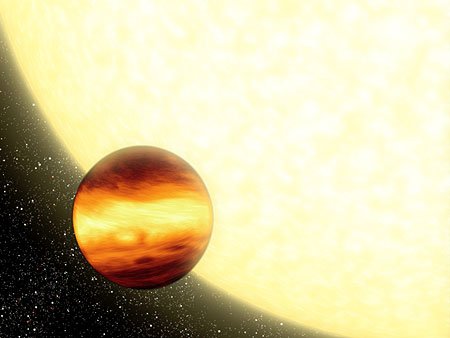
Any lingering doubts about whether water exists on a planet orbiting a star 63 light years away have been quashed by astronomers in the US. The team measured infrared light emitted by the planet, known as HD 189733b, and found distinct spectral features that, they say, can be explained only by the presence of water. Researchers had been puzzled because a previous attempt by the team to find water on the planet had failed, even though other astronomers claimed to have spotted the stuff.
One of over 300 extrasolar planets that astronomers have so far spotted, HD 189733b is a gas giant similar to Jupiter, orbiting its parent star once every 2.2 days and passing between Earth and the star as it does so. The first signs that HD 189733b contains water came last year when Giovanna Tinetti of University College London and colleagues studied the planet using the Spitzer Space Telescope. They looked at how the exoplanet absorbs light and found that absorption was at higher at infrared wavelengths associated with water.
Then another team (that also included Tinetti) used the Hubble Space Telescope to confirm the standard theory that the atmosphere of such a “hot gas giant” contains lots of water.
However, before either of these studies were published Carl Grillmair and colleagues at the Spitzer Space Centre in California and several US universities had studied HD 189733b using Spitzer. They found no evidence for water and these conflicting results left astronomers scratching their heads.
Subtracted light
Instead of looking at the light absorbed by the exoplanet, Grillmair and colleagues had studied the light given off by the planet itself. To do so, the team had collected light when the planet was in front of the star and when it was behind the star. Subtracting the two signals gave them the light emitted from the planet itself. In 2007 the team did this for two orbital periods and found no evidence of water.
Now, however, they have had another try, looking at 10 revolutions and found clear evidence for water. The team looked at infrared light with wavelengths between 5-14 μm, where they found a “bump” in the spectrum at 6.2 μm, which corresponds to a specific vibrational bending mode of water – a spectral feature that astronomers expect to see in such a hot giant (Nature 456 767 ).
Tinetti told physicsworld.com that she was pleased that her group’s 2007 sighting of water has been confirmed by Grillmair and puts the original discrepancy down to the extreme difficulty of making such measurements.
Help in the search for life
She added that the techniques developed by Grillmair and colleagues — as well as by other groups — could be used to look for water on rocky exoplanets that resemble Earth and could harbour life. However, she added that this may have to wait for the next generation of space telescopes such as NASA’s James Webb, because Earth-like exoplanets are much more difficult to find — and give off much less light — than their Jupiter-like counterparts.
In a related development, Tinetti and colleagues announced yesterday that they have used the Hubble Space Telescope to show that there is carbon dioxide in the atmosphere of HD 189733b. The team did so by making a measurement similar to Grillmair’s but instead looked in the 1.5-2.5 μm range. Earlier this year, methane was also found on HD 189733b, making it the most understood of all known exoplanets, according to Tinetti.



